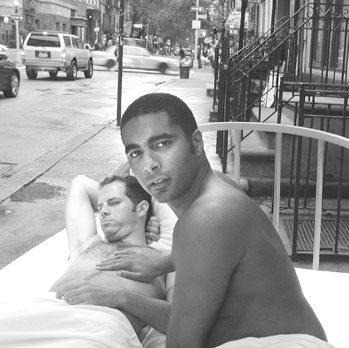Out of the theater & into the streets
The streets of Greenwich Village, long a place for acting out, are full of theatre on an average night. Now through the prodigious efforts of the Peculiar Works Project, you can see the ghosts of off-off-Broadway past come alive in a two-hour tour of 14 sites and even more seminal works performed by 50 actors in “Off Stage: The West Village Fragments.”
The ravings of a drag queen (Lanford Wilson’s “The Madness of Lady Bright”) or the sensual writhings of ten lithe actors (The Performance Group’s “Dionysus in 69”) may seem relatively tame today, but they were beyond “edgy’ in the 1960s. They changed the theatre and the culture, in ways that theatre rarely does today.
Peculiar Works wants to pay homage to this era, noting in a release that the “long-term mission is to persuade the city to install permanent plaques at each historic Village location in order to commemorate its artistic legacy.”
While the group with which I embarked from the site of the old Women’s House of Detention behind the Jefferson Market Library included Village legend Jerry Tallmer, the first drama critic for the Village Voice in the 1950s and founder of the Obie Awards (I’m eager to read his review in “The Villager”), my own theatre-going began just after the period it explores. So what’s old was new to me.
The conceit of the evening is to make the whole journey a kind of play with different characters leading the audience from one site to another, stopping to observe scenes from plays of the period. While a program identifies the works, the whole thing might have worked a lot better if our guides broke the fourth wall, explained the importance of sites we were visiting, set up the snippets—performed in costume with minimal sets and lighting right on the sidewalk—and alluded to their significance. More matter, less art.
That said, some of the tableaux could be arresting. Outside the closed Blue Mill Tavern on Commerce Street, Adam rejects Eve in Doric Wilson’s “And He Made a Her” and Eve in the Garden of Eden laments, “It almost makes me sad to think that all this will change.”
The Village has changed profoundly from the home of struggling artists and their companies to an elite residence for performers who have made it big and their accountants. But this show/tour at least had the effect of helping us to look at this unique neighborhood’s streets as the source of theatre they were and are. It was hard to tell at times who was part of this production and who just part of the actual street scene—even though so many Village characters are now gone or co-opted or, for that matter, condoned. And we the audience grew and diminished at each stop as pedestrians either passed through the scenes or stopped to watch. That aspect of it was very enlivening.
LGBT writers and themes were well represented, including Robert Heide’s “The Bed,” featuring an interracial male couple rolling around in one right there on Seventh Avenue South. “Hope you guys use a condom!” a young man shouted from his car, one of the better lines of the night.
There’s also pre-Stonewall stuff from Robert Patrick, William Hoffman, and Maria Irene Fornes, among others.
A faster pace and shorter excerpts would have helped this two hours without a break. But it ended on a grace note inside the Judson Memorial Church where a scene from the late pastor’s musical “In Circles” was resurrected while we rested our feet. “Messages are received all the time,” a final group of bright young performers sweetly sang. The messages bombarding us these days are more than many of us can bear, but this show reminds us of a time when just saying things on a stage could break things open.
gaycitynews.com


































